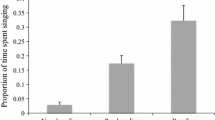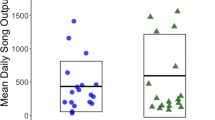Summary
We present experimental and correlational data that demonstrate that both the nutritional state of the male and his mate's fertility affect the timing and intensity of dawn and dusk song in the blackbird (Turdus merula). Food supplementation leads to paired males singing earlier, for longer, and at higher peak rate at both dusk and dawn succeeding the treatment. We argue that the timing, not just the intensity, of song conveys information about the male's phenotypic condition. Both dawn and dusk song start earlier and have longer duration as a male's mate reaches peak fertility indicating that, in agreement with literature on the great tit (Parus major), song at this time has particular significance in mate guarding for paired males of monogamous species. We discuss the relative importance of these factors as functional explanations for the dawn chorus.
Similar content being viewed by others
References
Armstrong EA (1963) A study of bird song. Oxford University Press, London
Åström G (1976) Environmental influences on daily song activity of the reed bunting (Emberiza schoenicus). Zoon Suppl 2:1–82
Birkhead TR (1982) Timing and duration of mate guarding in the magpie Pica pica. Anim Behav 30:277–283
Björklund M, Westman B (1986) Mate guarding in the Great Tit: tactics of a territorial forest-living species. Ornis Scand 17:99–105
Carlson A, Hillström L, Moreno J (1985) Mate guarding in the Wheatear Oenanthe oenanthe. Ornis Scand 16:113–120
Cheng KM, Burns JT, McKinney F (1983) Forced copulation in captive Mallards: III Sperm competition. Auk 100:302–310
Edwards P (1983) Behavioural ecology of British thrushes (Turdus spp.). Unpub D Phil Thesis, University of Oxford
Endler JA (1987) Predation, light intensity and courtship behaviour in Poecilia reticulata (Pisces: Poeciliidae). Anim Behav 35:1376–1385
Garson PJ (1978) A study of territorial and breeding behaviour in the Wren, Troglodytes troglodytes (L.). Unpub D Phil Thesis, University of Oxford
Garson PJ, Hunter ML (1979) Effects of temperature and time of year on the singing behaviour of wrens (Troglodytes troglodytes) and great tits (Parus major). Ibis 121:481–487
Kacelnik A (1979) Studies on foraging behaviour and time budgetting in the great tit (Parus major). Unpub D Phil Thesis, University of Oxford
Kacelnik A, Krebs JR (1982) The dawn chorus in the Great Tit (Parus major): proximate and ultimate causes. Behaviour 83:287–309
Leffelaar D, Robertson RJ (1984) Do male tree swallows guard their mates? Behav Ecol Sociobiol 16:73–79
Mace R (1986) The importance of female behaviour in the dawn chorus. Anim Behav 34:621–622
Mace R (1987a) Why do birds sing at dawn? Ardea 75:123–132
Mace R (1987b) The dawn chorus in the great tit Parus major is directly related to female fertility. Nature 330:745–746
Mace R (1987c) The dawn chorus: behavioural organization in the great tit (Parus major). Unpub D Phil Thesis, University of Oxford
McNamara JM, Mace RH, Houston AI (1987) Optimal daily routines of singing and foraging in a bird singing to attract a mate. Behav Ecol Sociobiol 20:399–405
Montgomerie RD (1985) Why do birds sing at dawn? Abstracts of spoken papers, 19th Int Etholog Congr, vol 1, p 242
Myres MT (1955) The breeding of the Blackbird, Song Thrush and Mistle Thrush in Great Britain. Part 1 Breeding Seasons. Bird Study 1:2–24
Pinxten R, van Elsacker L, Verheyen RF (1987) Duration and temporal pattern of mate guarding in the starling. Ardea 75:263–269
Radesäter T, Jakobsson S, Andbjer N, Bylin A, Nyström K (1987) Song rate and pair formation in the willow warbler, Phylloscopus trochilus. Anim Behav 35:1645–1651
Reid ML (1987) Costliness and reliability in the singing behaviour of Ipswich sparrows. Anim Behav 35:1735–1743
Sherman PW (1988) The levels of analysis. Anim Behav 36:616–619
Snow DW (1958a) The breeding of the Blackbird Turdus merula at Oxford. Ibis 100:1–30
Snow DW (1958b) A study of Blackbirds. George Allen and Unwin, London
SPSS Inc (1986) SPSSx user's guide. 2nd edn. SPSS Inc, Chicago
Stephan P (1985) Die Amsel. A Ziemsen Verlag, Wittenberg, Lutherstadt
Steffens R, Geiler H (1975) Der Einfluß exogener and endogener Faktoren auf die Intensität des Vogelsanges. Beitr Vogelkd 21:385–409
Sturkie PD (1965) Avian Physiology, 2 edn. Balliere Tindall and Cassell, London
Van der Baan GRé (1953) Seasonal variation in the dawn and dusk chorus of the Blackbird. Overdruk nit, DE Levende Natuur 10:193–199
Verner J (1965) Time budget of the male long-billed marsh wren (Telmatodytes palustris) in the breeding season. Condor 67:125–139
Ydenberg RC (1984) The conflict between feeding and territorial defence in the Great Tit. Behav Ecol Sociobiol 15:103–108
Author information
Authors and Affiliations
Additional information
Offprint requests to: I.C. Cuthill
Rights and permissions
About this article
Cite this article
Cuthill, I.C., Macdonald, W.A. Experimental manipulation of the dawn and dusk chorus in the blackbird Turdus merula . Behav Ecol Sociobiol 26, 209–216 (1990). https://doi.org/10.1007/BF00172088
Received:
Accepted:
Issue Date:
DOI: https://doi.org/10.1007/BF00172088




